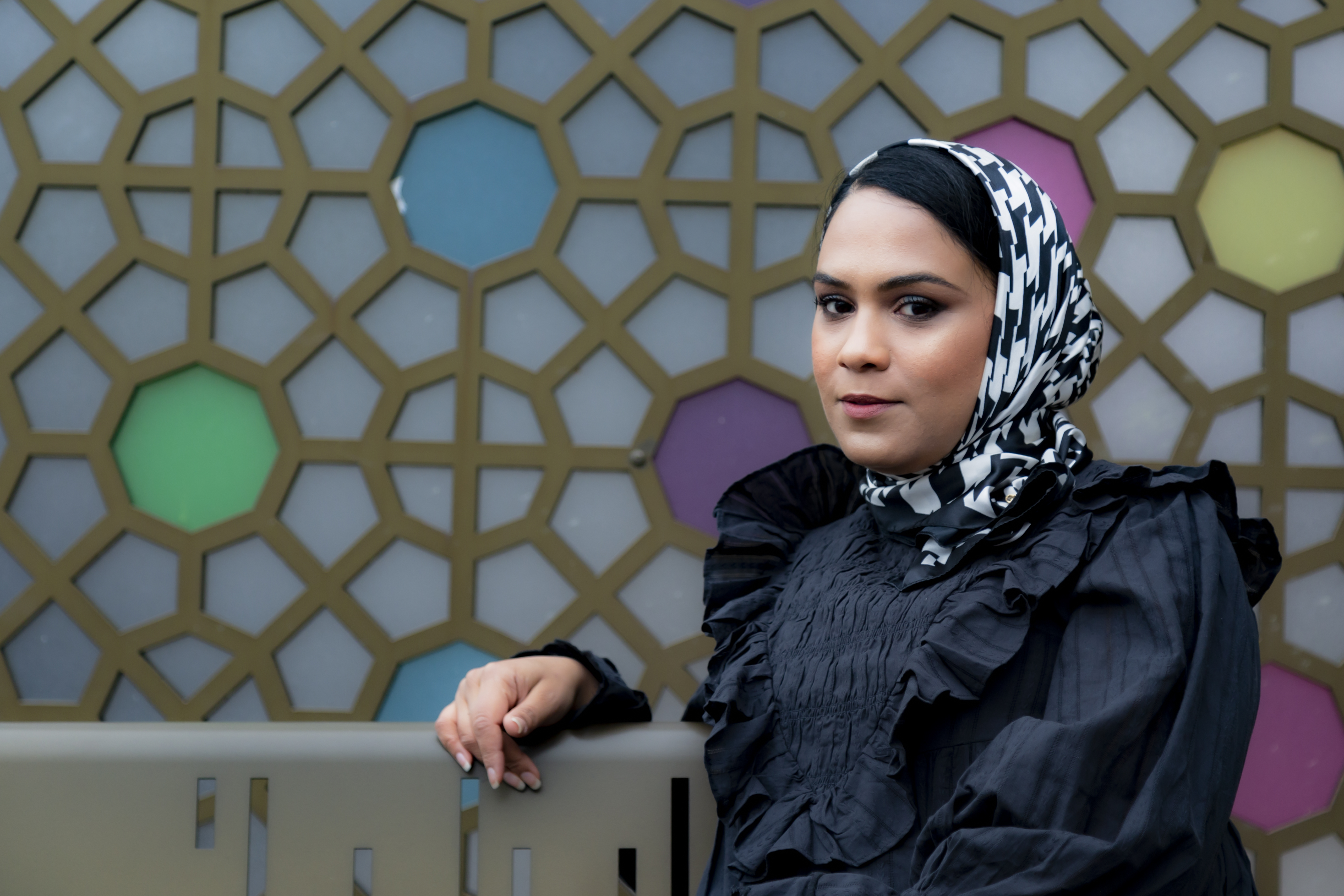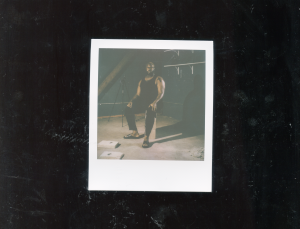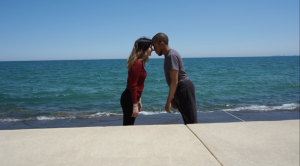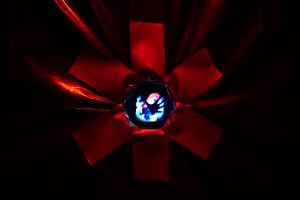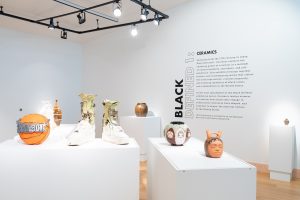Like many people who move to Chicago, Urooj Shakeel made the decision to relocate from a suburb of Detroit after realizing that if she wanted to try her hand at a career in the arts, now was the time. She doubled down and left long careers in healthcare and marketing to study arts administration and policy at the School of the Art Institute of Chicago.
Prior to her move, she took a moment to reflect on her love of Detroit and the ways in which it seeded her love for art. Urooj wrote on her website, “I could go on forever talking about Detroit and all the artworks I’ve come across, interacted with and studied. How each one of them inspired me in my own art projects and where my ideas originated from. I can never be thankful enough for my colossal beginnings in Detroit. Everything I’ve learned from this city will inspire me in everything I plan to do in Chicago.”
Her words foreshadow how she would shape her practice after landing in Chicago just over two years ago. While holding fellowships and positions at cultural institutions and foundations, Urooj graduated from SAIC in the summer of 2019. She wrapped up her studies with two ambitious projects that pushed her into new territory creatively and curatorially. One is an exploration of family legacies through language and a project that paid homage to the poetry of her nana, or grandfather. The other, Truck Art Meets Little Free Library, is a project that reimagines iconic emblems that are prevalent across Pakistan and other South Asian cultures, then places them in one of Chicago’s quintessential communities to provoke connection.
As Urooj enters the next chapter of her life and practice, she took some time to talk about collaborating with family, the art inherent to Pakistani and Islamic cultures, and the creative and spiritual growth that’s possible when you give yourself permission to take a chance.
*****
Tempestt Hazel: Tell me a little about yourself. Who are you and what brought you to this work?
Urooj Shakeel: I’m an arts administrator. I like to think that I’m a preserver of cultural art. Let’s take it all the way back: I’m Pakistani, but I grew up in the Middle East. I moved to Michigan when I was 7 years old and I’ve been in Detroit my whole life until I moved to Chicago two and a half years ago for graduate school. I just graduated from the School of the Art Institute with my Masters in Arts Administration and Policy. Prior to that, I was running a home healthcare agency in Southfield, Michigan for 8 or 9 years with my family—right after undergrad when I studied marketing. I learned a lot of good life skills and learned to conduct myself in the business world, but [marketing] lacked the space to be creative. I reached a point when I realized that if I don’t follow my passion now it’ll never happen. So I quit my job, went back to school, got a second degree in art history, then applied to SAIC. That’s how I ended up in Chicago.
What I really appreciate about Chicago is that the arts here are community-based. I’ve never been exposed to that and I think that’s a new concept in Detroit and especially in my culture. For me, being Pakistani and being South Asian, and Muslim, the arts are so integrated into life in a certain way where you don’t know what it’s doing until you start trying to put language around it. Or until you go into spaces where that’s not the norm. So that’s another thing that I learned in Chicago is that I was really fortunate to have a cultural and artistic upbringing. And by default, we had community because the arts for us were more leisure, so to learn about the amazing work that’s happening in Chicago and how art isn’t just classist or just about the art market. Here you see it working in the community and in different neighborhoods. It’s specific to the people who live there.
During grad school, I took these ideas of well-being and everything I learned in the home healthcare world and extended that into the art world–asking how I can utilize art to either bridge the gap between art and medicine but also share what I’ve always had access to but to also preserve it for new Americans who are in these spaces where it’s not the norm to have art around you all the time. How do we translate that into an American life setting, which is how I ended up with this idea of combining Little Free Library with Truck Art.
TH: What you’re saying about the American context is interesting—though I hesitate to say “American context” because I struggle with language that’s used around the idea of America. I think about conversations I’ve had with people who perhaps don’t see the art in something unless it clearly reads and is presented as art with a capital A. Often it’s instances when art is embedded within a way of life rather than art being segmented off as the art thing over here, and it obviously looks like art and is labeled art. For you, what does it look like when art is embedded in everyday life and infused in everything?
US: When I say art is in every aspect of my life, I mean it’s in the poetry, it’s in the textiles, it’s in the objects in my home. You don’t just put up a vase or a jug and put flowers in it. That vase has Islamic calligraphy on it, or poetry. It has images that have been carried on for centuries from Mughal art. It’s in our rugs and my clothing. You can tell by the type of textile someone’s wearing where they’re from in a specific country. The dialect of their language tells you where they’re from. I’ve always had a community and grew up in a very cultural household. We were involved in music and concerts. There were folk songs that I had always been exposed to, though I didn’t know what they meant and learned the meaning over time. There was no way to not come across art. You wouldn’t know how to exist [without it].
TH: If I remember correctly, your grandfather was a poet. Can you talk about the project you did in collaboration with his poetry?
US: My grandfather was a published poet, not by profession but it was a passion of his. I always knew that but I never read his poetry. I’d heard some of it, [but] I didn’t always fully understand what the words meant. His poetry was in Persian. It’s not something I can understand right away. One of my life goals was to take on this project and reconnect with him through his poetry.
I involved my entire family in this process. My aunt found his book for me. My other aunt would send me translations of it, and then transliterations in English. Then, I would sit down with my mom who would help me pronounce the words and she would tell me what they meant. Then we’d dissect it. It became a family activity. We all reconnected through his poetry, which was really amazing. And then, to share that with my community was amazing.
I actually memorized his poetry. I can recite it for you, and I know his history. And that took me into other avenues of learning about poetry in general and translating the folk songs I grew up listening to. I realized [that] this is deep. This is not just a celebration of culture, it’s praising the land through spirituality. Everything just made sense. And once the poetry made sense, the textiles started making sense, and the ways people act started making sense. It was such an enriching process for me.
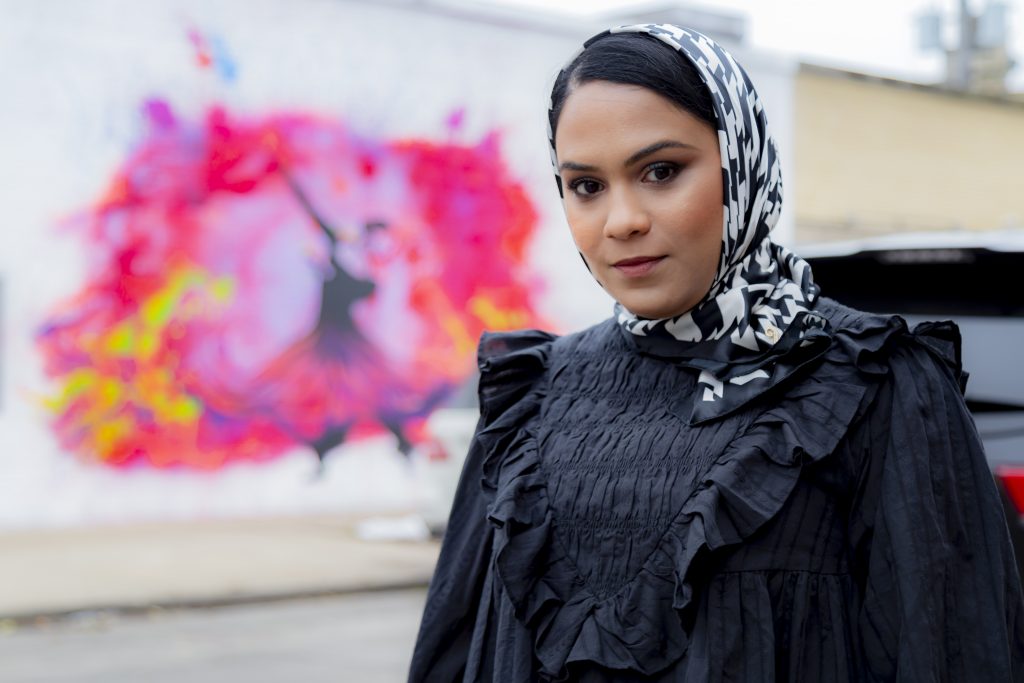
TH: How does the Chicago context influence how you think about your work?
US: Living in Chicago has really humbled me. Growing up in Michigan and living the suburban life, I realized right away that I’d been sheltered. I had tunnel vision about what I could do in the art world. Coming to Chicago and seeing people like myself–South Asians or Muslims–in philanthropy or the nonprofit world, and being successful at it, I didn’t know those were options for me. Chicago broadened my views on everything. Then, just being in community, being humbled, and being down-to-earth about things has really changed how I can share information with people. I’ve realized that people want to know more and they’re open to it.
Also, things are possible in Chicago.
TH: What do you mean by that?
US: Community projects. Going into different neighborhoods, seeing the work that’s being done lets me know that I can imagine anything and make it a reality. There are so many resources here and so many people who will support my ideas. Chicago has taught me that. It’s something I take [with me] every time I go back to Michigan. Chicago made my dreams come true in a way.
TH: I’m sure Chicago would blush if it heard you say that.
US: People have such opinionated views about Chicago but people don’t know the good happening at the ground level. I know in Chicago we’re aware, but other folks aren’t aware.
What I really appreciate, too, about Chicago is the collaboration that happens between communities. In Michigan, we were living along the margins comfortably. We were and still are self-sustainable. In recent times we’ve been reaching out to other communities, but when I got to Chicago I realized that this was already happening. So, my core network for this project wasn’t just South Asians or Muslims, it was everybody. And that was nice to experience.
TH: It’s interesting to hear you talk about being self-sustainable because perhaps that contributes to suppressing a curiosity that leads people to explore other communities. I don’t often think about how collaboration is used to sustain a community or how being self-sustainable decreases the need for collaboration. I’m thinking about how perhaps more collaboration happens when someone needs something and less happens when a community has the things they need. How does self-sustainability feed into your ideas around collaboration and community?
US: Well, that’s just it—it’s about needing something. After Sept 11 and then Trump coming into office, you have the Muslim community facing this huge dilemma of being targeted. For a long time, because we were self-sustaining and in our own bubble, we were under this impression of thinking, “it would never happen to us.” But when it did happen to us, it was a huge wake up call.
TH: And what’s the “it” you’re referring to?
US: The targeting, the generalizations made about us. We quickly realized that we not only failed ourselves, but we failed other communities by not reaching out. We’ve been working to educate ourselves about different experiences and struggles—-the Japanese Americans and what they went through, African Americans and their struggle. We are making efforts to reach out and let people know what we can do to help. You have these different communities now coming in different spaces and realizing that we’re all more similar than we are different. And it takes collaboration to sustain not just yourself, but everybody. So, to come to Chicago and be working at a place like Field Foundation that’s supporting Arab American Action Network or IMAN [Inner-city Muslim Action Network]—to have these nonprofits in Field’s portfolio was so surprising to me. It told me that yes, we can be seen in these spaces.
I also realized that we were able to come from a community that was self-sustainable because it was a wealthy community. The reason why we could enjoy the art and culture that we had, and create the foundations that we have, was because our [families] could afford it. So, how can we help other communities create models like we have but then for us to also learn from them about the work that they’re doing.
TH: But to be able to dream something up and make it happen in community is a perfect segue into the Truck Art Meets Little Free Library. Can you talk about where your inspiration for this project came from?
US: Truck Art Meets Little Free Library for me is putting all the pieces of the puzzle together, in a way. It’s taking all my sketches from different points of my life and creating a beautiful masterpiece out of it. It combines everything I’ve been investigating on my own. How I came across truck art is interesting, too. I’ve always known about truck art. We’ve always seen them in Pakistan. But a lot of us didn’t know the history of them. I just assumed the drivers were the artists and they took traditional folk designs, then painted them on the truck.
A couple of years ago I set out to learn more about Islamic calligraphy. I ordered a book called “The Aura of Alif: The Art of Writing in Islam” and the last chapter was dedicated to truck art. And I wondered why that was in an Islamic calligraphy book. It turns out the art form originated from Islamic calligraphy because the drivers of the cargo trucks hired calligraphers to write the name of the company and their name on it, but the [drivers] pushed it even further, asking them to paint other things on it. So, the driver and the artist started collaborating with one another to create images, landscapes, and anything the driver wanted on the truck. It became an artisan trade. So, again, not only is truck art visual poetry, it’s rooted in religion as well. It ties in all these aspects of Sufism and Quranic beauty.
I had that always in the back of my mind. Then, in my first year of grad school, I took a class with Lisa Stone at the Roger Brown Study Collection, and she introduced me to the world of outsider art. That’s another thing that I learned about when I moved to Chicago and how it aligns with the healthcare field. I told her that I had really been thinking about what outsider art is in my culture and I realized it was [things like] truck art. And since I live in Edgewater, I kept coming across these little libraries everywhere and I kept wondering, “What is this? This is such an interesting concept!”
I remember seeing one by an elementary school near my apartment, and I remember thinking, “What if there was a Little Free Library in the form of a truck?” I had this thought and giggled to myself thinking it was silly and impossible. But I told Lisa about it and she pushed me and encouraged me to pursue this. And also think about what contemporary art looks like in Pakistani culture and how far can we deviate away from traditional art. I realized that we can’t, it’s just who we are. We’re never going to make this fully abstract style of painting. Traditional folk designs are still going to come through. So, that combined with my interest in poetry, I put that all together. Then, Lisa suggested that I could put it on Devon. And that’s how my journey started.
TH: Leading up to this conversation we talked about how, when you’re walking along Devon you get a sense of culture just because of the people who live there and the activity happening along that street. But perhaps unlike other neighborhoods where the visual symbols of the predominant cultures and ethnicities who live there are plastered all over the walls and can be seen all along the streets—I think of Pilsen or Chinatown. Certain areas are really about visually painting their history and culture in a very public way. And something you mentioned as differentiating when it comes to Devon or West Ridge is how it’s perhaps quieter because it’s in private spaces or not as present at street level. Your project stands out because it inserts something visually striking and culturally distinct in a very public place. Can you talk a bit about that and the presence that something like this has?
US: Devon is an interesting street because it’s a culture within a culture.
TH: And the street itself isn’t really a neighborhood—it runs through several different neighborhoods.
US: Yeah, and there are so many layers of different histories of people who have occupied that space. Even the way people live there now is interesting to me. Part of me is an outsider and part of me is an insider, right? But what’s interesting, too, is that it’s commercial. It’s restaurants, it’s businesses. Then the community that lives there is behind all of that and not quite visible. They are living in a kind of bubble and they prefer that. So there’s no need to make art flashy because it’s already present through the food and the clothes. Then, with the recent renovation they did to the streetscape in 2015, they’ve been trying to make art more prominent but it can be very generic and like pseudo-branding with a repetition of the same designs. There’s the mural on the street and the Mughal inspired screens, which I actually don’t think looks very Mughal. If anything I think it disrupts the street. But having something like truck art on [the street] shows a way [for things to] not be dictated by outsiders—it’s coming from within. It’s also taking so many aspects of the history of not only Devon but the different cultures, then making it Chicago-centric. It’s really putting together these different identities for people to feel safe in public spaces and to own those spaces. To also be able to look at this truck and say, “That’s my life history.” Or open up dialogue between people who speak different languages. And connect with each other by realizing that there are trucks like this across cultures but they may look [a little different].
I think that’s what this truck is doing. It’s not just providing free books to people. It’s not just activating public space for children. It’s also opening up dialogue between the different cultures that exist there.
TH: Are you taking a cue from other spaces that exist on Devon that are trying to do this kind of relationship-building between communities? Or do you feel there is a separation between the different communities, cultures, or nationalities that are located there?
US: I think there’s a little bit of both. People exist in their own spaces next to each other, but I always wonder if they talk to one another. For me, always being a tourist to Devon and coming from Michigan I never wondered about who actually lived there. Then, I saw the different kinds of people. I saw the influx of immigrants who were coming in who weren’t South Asian. I wondered how they were handling this. Then, there were nonprofits popping up—Devon wasn’t always a place for nonprofits.
When you’re in your own bubble, there isn’t always the need or desire to collaborate, right. And with the city, they’ve developed an SSA for Devon, and they’ve built an online presence. They are trying to bridge those cultural gaps. Much of it is tied to commercialization to build the economy. So, that’s why with my project, I’m not asking for anything. It’s not asking for money. It’s just there to give.
TH: Have you been able to witness some of the residents’ and passing public’s engagement with the library outside of the unveiling event? I’m so interested in the things that happen with public art when the creator isn’t watching—there’s so much that you’re not seeing. What have you seen?
US: I have just been waiting to take this into the public just to see what people say. I helped Sabba Elahi paint the truck toward the end—she’s the artist [who painted the truck] and she lives in Evanston. When we took it outside to add the varnish, these little kids were walking by saying, “Wow! What is that?” Older people were stopping by and asking us to explain what it was. They were so fascinated by it. It made me realize that I was onto something here. If this was the initial reaction with non-South Asians, I was really interested in what South Asians had to say. So, on the day of install at the healthcare center, people were constantly stopping by asking about it or saying how they recognize and see themselves in it.
I also created a template of a truck on paper that was meant to be used for a workshop with kids. But it just so happened that the day we installed, there was a [senior and older adult program happening]. We made copies of the drawings and handed it out to the women who were from all backgrounds—Pakistani, Indian, Bangladeshi, Bosnian—many who didn’t speak the same language. But they were there decorating the trucks and adding designs from their respective countries, creating these beautiful pieces of art and sharing them with one another. Another man came up and started reading poetry on the truck. He started telling us his life story as we’re digging the hole [to install the truck]. I was explaining to my brother, [who was there with me], that this man just wanted to be heard! He just wanted us to listen. And he felt so proud to be able to see his culture out in the street.
I was just there yesterday and someone from the hardware store that’s connected to the Hamdard Healthcare Center came out and asked what it was, saying that everyone keeps coming into the store asking about it. So I gave him a brief history and he said, “Wow, this is amazing!” He wanted to know more. He wouldn’t leave and just kept asking questions. He said the news outlets should be out there covering this because all we keep hearing about [Chicago] is murder and gun violence. He said he wants to hear more about things like this.
It was so crazy to me. There’s this Pakistani truck on the street next to all these Western cars, and people are stopping as they walk by asking questions. I like to see people’s reactions. They often do a double-take. That’s been really cool.
TH: How was it collaborating with Sabba on this?
US: I wrote in my thesis about how I’m looking forward to the time when Sabba and I aren’t only just designing the truck and painting it together, but when we’re having conversations about it. She was beyond perfect for this project because she would go back and forth about our cultural knowledge. We found out how much we had in common. We were able to be in dialogue about our life histories and stories. Sabba and I are like the truck driver and the artist—we’re collaborators in the same way that they are collaborators to make something beautiful. That’s really what this piece is.
Sabba being a Chicago native was very knowledgeable about things like Chicago birds and plants, which she incorporated in the truck. If you look at each panel the designs are from the original buildings on Devon that were built by Jewish immigrants. Each panel pays homage to a Chicago landmark in different neighborhoods. She taught me a lot about Chicago through this.
I shared a lot about my poetry knowledge and cultural and textile knowledge. In the front of the truck is designs from Ajrak, a textile from the Sindh Province of Pakistan. It’s a textile and pattern that is rooted in the Sindhi people, the ancient Indus civilization. The materials come from the land and it’s a month-long process to dye the fabric. You can see that represented on the truck. I was able to tell her about when I traveled to different Sindhi villages to learn about Ajrak. The dialogue between her and me throughout this process is the same type of dialogue that I hope other people have.
TH: What is a piece of art, an artist, or a cultural worker who has been really influential for you and how you think about your work?
US: Tracie Hall. She came to SAIC and was on a panel with Angelique [Power] actually. But prior to that, she came to my class to talk to us in my first semester. I just fell in love with her and wondered who she was. What I really appreciated about Tracie Hall was that she wasn’t afraid to talk about spirituality in her work. She was so adamant about incorporating that in who she is and how she conducts herself as a cultural worker. She took me on a new path and made me realize that arts administration isn’t about what I do, it’s about who I am. And if I can incorporate every aspect of me into my work then it means so much more. And I shouldn’t be afraid to bring spirituality into it and the deeper connection that we have to land. Also, how we exercise imagination in order to make those connections. If I do that, then I’ve done what I’ve set out to do. That’s art. It’s not something you just look at and analyze. It’s connected to a deeper existence. So, to hear Tracie talk about these things through a spiritual lens has been so enriching for me. To be in her presence is so amazing. She’s such an inspiration. And though I’m not a Black girl who grew up in America, in some ways it’s like Angelique says, it’s our transcultural existence, we get each other, and it’s such a community. And to have someone inspire me and let me know that I can approach arts administration through spirituality has been one of the most rewarding things about being in Chicago.
TH: So, you’ve been working on the Truck Art project for a while. You’ve seen it manifest and now it’s doing its thing out in the world. What I don’t want to ask you is, “What are you doing next?” because there’s still plenty to do now! So, instead, I’ll ask what are you thinking about right now? Where do you go from here?
US: That’s a great question because I have been waiting for this project to be out in the world so that I can finally talk to people about my process. The process is what I enjoyed the most. I want to engulf myself in the poetic beauty of truck art. But I also want to learn more about myself and put the pieces of the puzzle together. I want to seek out other Pakistanis who are talking about and doing similar things. I want to talk to organizations that are recording our life history. Now, I can say this is my contribution and explain how I got here. There are so many different aspects of this project that I want to share with people.
I mentioned how one of my aunts helped me with the translation and transliteration of my grandfather’s poetry and she was someone in my family who recorded all of our histories. She recently passed away so I was able to dedicate this project to her. Now, I can share with the world why this project means so much to me. It’s not just something I wanted to put up and move on from. It’s something that will go with me my entire life. It’s helped to shape me into the person I am and the person I want to be. I can share this with future generations.
So when you ask, what’s next. The sky’s the limit.
Featured Image: Looking directly into the camera, Urooj Shakeel poses in front of a geometric, multicolored wall, seated with her hand resting on the back of the bench. She is wearing a black top and a black and white hijab with a houndstooth pattern. Photo by Mark Blanchard

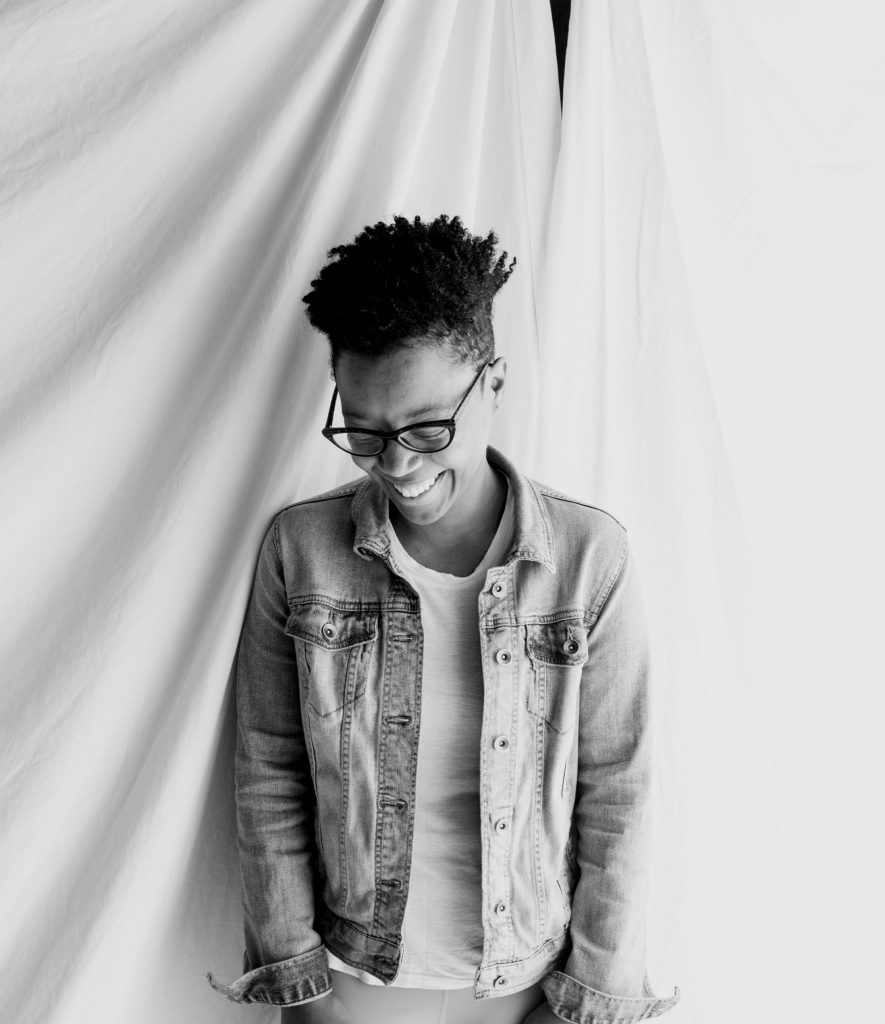
Tempestt Hazel is a curator, writer, artist advocate, and co-founder of Sixty Inches From Center. Find more of her work at tempestthazel.com. Photo by Brian Guido.
